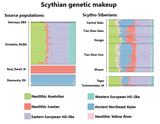>>515073241
>Additionally, one specimen (6.25%) carried haplogroup N-M231, which is associated with Neolithic remains from Northern China
>The Scythian groups of the Pontic Steppe and South Siberia had significantly different paternal genetics, which suggests that the Pontic and South Siberian Scythians had completely different paternal origins, with almost no paternal gene flow between them
>Since the Middle Iron Age onwards, the Eastern Scythians received additional Northern East Asian geneflow, paralleling the emergence of Huns, which shared this newly arrived component. There was also an increase in Sarmatian and BMAC-like ancestries
>Unterländer, et al. (2017) found that eastern Scythians share closest genetic similarities with modern-day speakers of Siberian Turkic languages, such as Telengits, Tubalars, and Tofalars, which supports a "multi-regional origin" of the eastern Iron Age Scythians
>Eastern Scythians share partial ancestry with contemporary Turkic, Mongolian, and Siberian groups in eastern Eurasia, while evidence of genetic affinity with Scythians is strongest among modern speakers of the Kipchak languages. There is increasing evidence for a partial continuity from the eastern Scythians to the Turkic-speakers of the Altai region, as well as modern Uralic and Paleosiberian peoples
>Turkic-speaking Central Asians can be described as having formed from mixture between Scythian-like groups, displaying their highest genetic affinity to modern day Tajiks, and "Eastern Steppe Xiongnu" groups during the Iron Age. The mixture with West Eurasian sources was found to be "in accordance with the linguistically documented language borrowing in Turkic languages"
